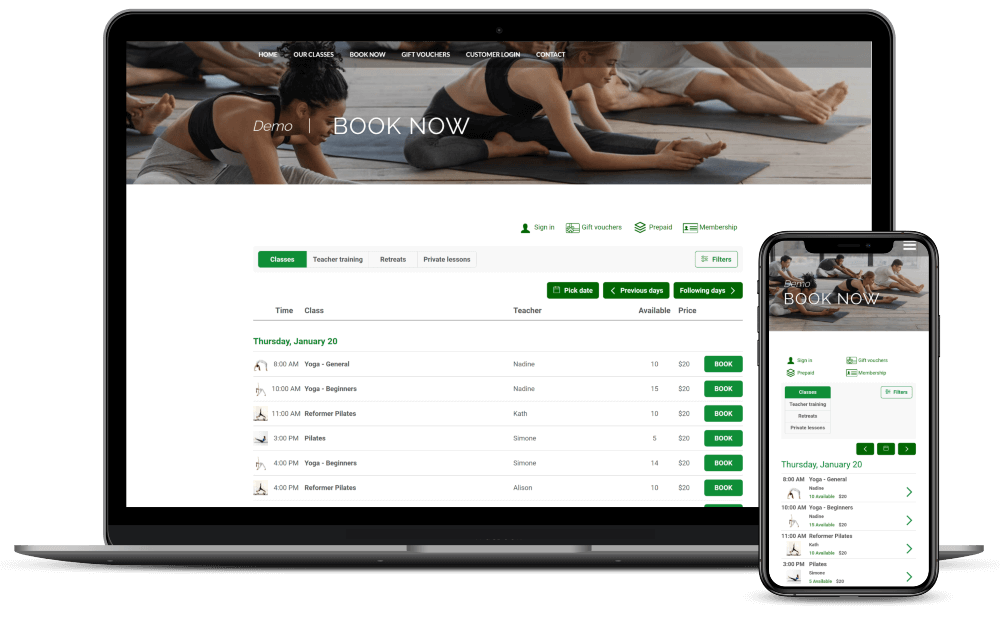
Yoga Studio Marketing in 2025: Ultimate Guide
Even before the global COVID-19 pandemic, marketing a yoga studio was already quite challenging with the tight competition in the industry.
However, that’s not saying the yoga industry is slowing down. Yes, it’s no secret that the industry has been heavily affected by the global pandemic, but at the moment, the industry is still worth more than $88 billion worldwide and is still expected to grow to reach a $215 billion market size in 2025.
So, there’s definitely enough demand for your yoga business in 2024, but you still need to market it right. It’s crucial to choose the right marketing strategies and channels to maximize your marketing investments and generate the best results possible, and in this guide, we will learn how.
In this ultimate guide to yoga studio marketing in 2024, you’ll learn about:
- The basic concept of marketing a yoga studio as a service business
- How to differentiate your service from your competitors
- Five important pillars of yoga studio marketing
- Effective marketing ideas and tactics you can try to grow your yoga business in 2024
And more.
Without further ado, let us begin right away.
Marketing a Yoga Studio: The Concept
It’s crucial to remember that a yoga studio is, by nature, a service business, and marketing a service business requires a different approach than marketing a product-based business.
Why? Providing a service’s tangible value is obviously more difficult than promoting a product your target customers can physically see and touch. Also, when a customer or client purchases a service, they don’t actually own what they pay for.

Marketing experts have realized this issue for quite some time, giving birth to “services marketing” as a separate branch of marketing in the early 1980s.
Below are some unique considerations why services marketing (including Yoga Studio marketing) requires different strategies than selling physical goods:
- While service providers are essentially selling their (or their worker’s) skills and experience, competency level doesn’t really matter. They only care about the end result and their experience when purchasing your service, in this case, whether they enjoy your yoga class and whether they feel they’ve learned something.
- Delivering a service typically involves multiple interactions rather than a one-time transaction when purchasing physical goods. More interactions may translate into more obstacles along the way that may result in the customer abandoning the purchase.
- Since it’s more difficult to prove the tangible value of a service, a core part of services marketing should be about establishing trust and credibility. You’ll need to convince your prospective clients, so they are comfortable enough to join your yoga class.
For the rest of this guide, we will discuss how we can develop a comprehensive marketing strategy for your yoga studio while considering the above challenges (and more.)
Yoga Studio Marketing: Creating Unique Value Proposition
As discussed, proving a service’s value to customers can be more challenging than marketing a physical product where we can highlight its physical qualities and features.
Yet, various service industries, including the yoga classes industry, are getting more competitive and even saturated. If you can’t differentiate your yoga studio from your competitors, getting noticed amidst all the noises can be very challenging.
Without first establishing your Unique Value Propositions (UVPs), any marketing efforts for your yoga studio are literally doomed to fail.

So, how can you differentiate your yoga studio business and create UVPs? Below are several service differentiation factors that can help you in designing a yoga studio business with unique values:
- Price: pretty self-explanatory. A lower price (in relation to the value offered by the business) will always be more attractive to potential clients.
- Value/function: the benefits the clients can get from a service or things that the customers can achieve with the said service. For example, a customer may find your class valuable if they’ve improved their back mobility after joining your class.
- Environment: such as the architecture and decor of your yoga studio, proximity to public transportation, parking availability, etc.
- Brand identity: service businesses with strong branding and consistent brand promise can attract more clients.
- Convenience: how accessible and easy it is for your customers to book and use your service. For example, whether you offer 24/7 class scheduling and booking.
- Credibility: how much the customer trusts you. Many factors can contribute to this, like how experienced your yoga instructors are, number of years in the field, certifications, and more.
- Personalized service: for example, offering a VIP membership to students so they can join exclusive classes.
- Self-service: features and tools that allow customers to do things quickly for themselves, as opposed to having to call or visit.
- Variety: the variety of services you offer, like different types of classes and unique lessons. However, it’s crucial to find the right balance between offering too little and too much variety.
- Terms: making terms simpler or more accessible than the competition. For example, if other classes in your area are membership-only, you may be able to attract more clients by offering a pay-per-visit model.
The better you can establish your UVPs by considering the differentiating factors above, the more attractive you’ll be in the eyes of your ideal customers.
All your marketing efforts should focus on communicating these UVPs, while you should also design the UVPs based on thorough market research, as we’ll discuss below.
Yoga Studio Marketing: Market Research
To be effective, your marketing strategy must begin with proper market research that involves thorough assessments of three things:
- Identifying and understanding your target audience
- A SWOT analysis of your yoga studio to identify your weakness and competitive advantage
- A competitive analysis to weigh the strengths and weaknesses of your competitors
Knowing and Understanding Your Target Audience
Who is your yoga studio business for? Is there a substantial quantity of this type of audience in your area?
Develop a buyer persona, a semi-fictional model to describe your ideal audience’s demographics and behavioral data so you can have a better understanding of who your ideal audience is.

Here are some tips in identifying your target audience and developing a buyer persona:
- Start with your existing customer base: if you already have existing clients, then you can try to identify patterns from them and develop your buyer persona based on these insights.
- Think of who needs the benefits you are offering: list your UVPs (as discussed in the previous section), and identify who has a need or interest in your yoga classes. Start narrowing it down from there.
- Send out surveys: another effective method is to send out surveys to existing clients, so you can identify who the leads who actually convert to clients are. Nowadays, there are various tools that can help you easily create and send surveys (i.e., Google Forms), so there’s no reason not to do this.
- Monitor social media: monitor social media conversations, including in popular online forums like Quora and Reddit, to identify who is asking questions related to the yoga niche. This can help you narrow down the demographic data of your ideal audience.
- Competitive analysis: keep a close eye on the competition, and check who their clients are and how they approach their marketing strategy. Chances are, your closest competitors are targeting the same audience as your ideal audience.
An important principle in developing your buyer persona is to keep things simple. Don’t overthink it, and you don’t have to make it too detailed. Start simple, and fine-tune the buyer persona as you go.
7Ps of Yoga Studio Marketing
Now that you’ve identified who your ideal audience is, you can start developing the 7Ps of your Yoga Studio Marketing:
- Product
What types of yoga classes will you offer? Will you also send on-demand online classes?
Design your offers by considering your target audience’s pain points and behaviors, as you’ve identified in the previous steps. Also, don’t forget that your customer service, as well as things that directly interact with potential clients like your website, social media profile, and Google Maps listing, should be considered your “product.”
- Price
How will you price your yoga classes?
The yoga industry is a relatively price-sensitive one, and your service’s price will not only affect your studio’s ability to attract new customers but also subsequent satisfaction.
It’s very important to be aware of how much your competitors are pricing their services and your target audience’s sensitivity range. Also, remember that price in yoga classes is often taken as an indicator of quality, so you also wouldn’t want to price your classes too low.

Finding the sweet spot is key, and here are several common pricing strategies you can implement for your yoga studio:
- Economic approach: setting an affordable price that can’t be beaten by your competitors. In short, you are sacrificing profitability. This approach can be quite effective if your audience’s price sensitivity is high.
- Penetration approach: initially offering (very) low price for your classes to attract new clients/students and acquire market share, then gradually increasing your price as you grow.
- Premium approach: if you are confident about your UVPs (i.e., you have the best facility in town or you have a famous yoga instructor in your team), then you can justify offering premium pricing.
- Product line approach: offering multiple classes with different prices to attract different types of audiences.
Again, base your pricing strategy on your target audience’s preferences and behaviors.
- Place
Your yoga studio’s location (proximity to your target audience), architecture/decor, cleanliness, and other factors will play a significant part in convincing prospective clients to join your classes (and your existing clients to keep coming back.)
If you are offering virtual classes or a mobile yoga studio (in which you are the one visiting your client’s premises), then you can skip this.
Nevertheless, if you have a great location and/or studio, make sure to leverage this fact and emphasize it on your marketing materials.
- Promotion
Pretty self-explanatory, no matter how great your studio and your service are, you won’t attract enough clients if you don’t promote your business right.
We will discuss channels and strategies you can use to effectively promote your yoga studio in the later section of this guide.
- People
Your marketing success will ultimately depend on whether you can convince your target audience that you offer credible and trustworthy yoga classes.
It’s also very important to manage customer relationships properly to keep your existing clients coming back for more classes (retention).

Again, the success of your marketing efforts will depend on how well you understand your target audience and how well your service can answer their needs and problems.
- Process
Especially important in services marketing where it’s not always about the service itself but how you offer an experience journey.
Here you should consider every touchpoint from when your clients started becoming aware of your business until they’ve finally joined your class, including:
- Your content (social media posts, blog posts, etc.)
- Your website (whether it’s mobile-friendly, loads fast, and well-designed)
- Reservation/appointment experience, whether you offer reliable 24/7 online booking
- The actual service
- Customer support
- Responding to reviews/feedback, including and especially the negative ones
- Physical Evidence
While you are not selling physical goods, it doesn’t mean you can’t provide physical evidence about your business’s credibility. There are three things you should focus on when elaborating physical evidence in your marketing efforts:
- Facilities: your yoga studio/class itself, but also your website, mobile app (if any), equipment in your studio, and so on.
- Infrastructure: how reliable/fast your website is, whether you have a reliable online booking function, etc.
- Service delivery: the actual delivery of your service.
Top Marketing Ideas To Market Your Yoga Studio
Based on the principles we’ve discussed above, here are some actionable ideas you can use to effectively market your yoga studio business:
1. Establishing a Strong Brand
Having a strong brand is a must for a yoga studio business, or else you won’t get noticed amidst the saturated competition.
Again, you are not selling any physical goods, and you are essentially selling the yoga studio itself.

While yoga studio branding is a pretty deep subject on its own and may deserve its own guide, here are some important branding principles you can use:
- Choose a name that is:
- Easy to pronounce
- Catchy and easy to remember
- Relevant to what you are offering. The easier it is for potential clients to comprehend what kind of yoga studio you are from your name, the better.
- Your logo should support your brand name (and not the other way around). Design the logo based on your target audience’s preferences. If, for example, you are targeting younger people for your yoga classes, then you can make your logo more fun.
- Choose the right brand color(s) that will support your logo and brand name. Again, base your choice on your target audience’s demographics and behavior, and make sure your color scheme can express your brand’s message.
- Consistency is key to strong branding. Make sure all your brand’s visual elements, including logo, brand colors, and so on, always appear the same wherever they appear. Also, make sure your brand messages are clear and consistent.
Once you’ve established your brand, make sure all your marketing efforts and creative campaigns align well with this brand identity. Again, consistency is key, so as early as possible, you should establish a core concept of what your brand message is.
2. Strengthen Your Online Presence
In this digital age, having a strong online presence is a must, or else you won’t get noticed by your target audience.
Establish a strong online presence in four main areas:
- Your website
- Social media presence
- Google Maps listing
- 24/7 online reservation function
A well-designed and functional website
Your website is your digital business card and is often your prospective client’s first impression of your business besides your social media profiles: when prospective clients stumbled upon your yoga studio, for example, from Google search, most of them will check your website.
It’s important to note that although you already have a relatively strong social media presence (i.e., 5k+ followers on Instagram), your social media profiles are not sufficient replacements for a professional website.

Fortunately, there are now platforms like Wix, Weebly, and Squarespace, among others, that can help us in designing a professional-looking and functional website in a very easy and affordable way. You can build your website on an intuitive drag-and-drop interface with a very affordable monthly subscription model. If you’d like more versatility in customizing your site, there’s also the handy (and free) WordPress that allows you to add Bookeo WordPress scheduling plugin for your website.
Make sure your website is:
- Mobile-friendly, many of your prospective clients will visit your website from their mobile devices.
- Technically optimized and loads fast.
- Easy to navigate.
- Optimized with your brand elements (logo, brand colors, etc.)
- Filled with rich and valuable content so it can act as a centralized hub of information for your yoga studio.
Social media presence
It’s fairly obvious to promote your yoga studio on social media, where most of your prospective clients are nowadays.
Yet, everyone is also doing the same, and so how can you build a strong social media presence amidst all the noises?

It’s crucial to understand that in promoting your business on social media, there are three different channels to consider:
- Organic: this is about building your own follower base and regularly posting to your audience. Organic social media is mostly free, but it will take some time (and it is difficult) to generate the desired results.
- Paid: using the paid promotion options offered by the social media networks (i.e. Instagram Ads). It can virtually guarantee fast results but will cost you money. If you are not careful, while you can bring in new visitors, you may lose money as a result.
- Influencer marketing: partnering with relevant influencers that can help promote your yoga studio to their followers. It can be very effective if you can partner with the right influencers.
Building a strong social media presence is finding the sweet spot between the three different channels: using paid promotions and influencer marketing, but also building your own organic presence to balance out the costs.
Again, the key here is a thorough understanding of your target audience.
Google Maps SEO
Nowadays, people rely on Google search in finding new businesses, including yoga classes and studios near them.
Your prospective students may search for yoga classes with queries like “yoga class near me” or “yoga studio in (city name)”, and you’d want to appear in the results for these queries.

The thing is, Google now pulls results from Google Maps for these types of local queries and will put the Google Maps results above the organic results.
This is why you should perform Google Maps SEO, and you can perform it in just four basic steps:
- Create or claim and verify your Google My Business listing
- Optimize your listing, focus on providing complete, accurate information for your target clients
- Build local citations by listing your yoga business on relevant online directories
- Get more positive reviews from students, especially on your Google Maps listing, but also on other relevant sites and platforms.
24/7 online reservation and scheduling
Today’s clients simply expect to be able to easily schedule a yoga class online, anytime, and straight from their mobile devices.
Consider the fact that more than 40% of online bookings happen outside business hours, so if you don’t offer a 24/7 online booking function on your website and Google Maps listing via Reserve With Google, you are potentially going to miss out on a lot of prospective clients.
 Fortunately, adding online booking functionality today is just as simple as integrating a yoga booking system into your website and application.
Fortunately, adding online booking functionality today is just as simple as integrating a yoga booking system into your website and application.
3. Build Partnership With Local Businesses
Don’t underestimate the power of collaborating with other businesses in your area.
For example, you can partner with a vegetarian restaurant in the area targeting health/wellness-conscious customers and do a cross-promotion campaign.
Check out local businesses with customers that may be interested in yoga classes, and approach them for partnerships.
4. Customer Loyalty Program
Marketing your yoga studio isn’t solely about acquiring new clients, but also keeping your existing clients happy so they can keep coming back for more.
In fact, retaining clients may be more profitable than attracting new clients.
One way to manage retention is to create an attractive customer loyalty program. You don’t really have to overthink this, and you can start with simple campaigns.
For example, you can offer customers a free class after they’ve joined four or five different classes, and it may already be attractive enough.
5. Email Marketing
Email marketing is also especially effective in retaining existing clients, so you should use it in conjunction with your customer loyalty campaigns.

If you already have integrated a yoga scheduling solution, it should automatically collect your clients’ email addresses as they book your service online, and you can use these email addresses to start building an email list.
Personalization and automation are the secrets to successful email marketing, and you can check guides on email marketing to learn how to send the right message to the right people at the right time.
Wrapping Up
While marketing a yoga studio can be challenging, by following the principles and the actionable tips we’ve shared above, you’ll have a solid foundation you can use to build an effective marketing strategy for 2025 and onwards.

